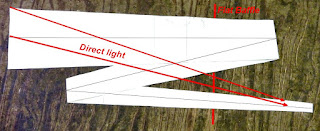*
A baffle tube projecting forwards from the focuser is fine if it is
both short enough and large enough to let the light cone enter. This
part of the beam is straight on to the focuser. There is no tilt. The
same is true with the light cone just after the objective. It is obvious
that the objective is not tilted either. If the baffle tube is made too
long it will cut off the light cone. All this is easy to see if you
stare through the empty focuser and insert a piece of card into the
view.
The problems start where the tapered light beam
crosses between the two flat, folding mirrors. Each small mirror
both receives and reflects at two different angles. Trying to baffle
anywhere near the crossing is difficult.
The
image shows a full sized, folded, drawing of the tapering light cone.
This was very handy to place the mirrors during development of my folded
7" refractor design. The precision, folding mirrors are of finite size. [5" & 4" Ø] They
don't want their area to be wasted. Nor must the light cone overlap the
edges of the mirrors. Which would cause serious vignetting. A baffle
plate, placed at the vertical, red line, would need complex cutouts to
block direct light from reaching the focuser.
I had the completely daft idea of using the sun to show where the light spots fall on a baffle plate. Don't even think about it!! The risks are simply too great! Particularly with a large aperture objective.
Bright
moonlight or a fairly distant car headlight should work as a parallel
light source. Mark the intended baffle where the light cone forms a
bright circle of light and then cut it out. Then look for the next
bright spot on the back of the baffle plate. There will obviously be a
pause in between these actions because the baffle plate will need to be
removed for cutting out the circle and then the plate replaced in the
OTA.
Because my folded OTA is an open frame a tubular
baffle pipe in front of the focuser will help to exclude stray light
from outside the OTA. A larger pipe to clear the FT drawtube could have a
smaller baffle at its mouth to block grazing reflections. This baffle
tube should be firmly mounted on the lower frame to avoid conflicts with the
focuser. There is no room for a supporting flange on the backplate.
I tried various lengths of 110mm tube to see if I could shield the focuser from the direct light coming from the objective. I just happened to have some scrap aluminium tube in that diameter. This size just slides nicely over the FT drawtube with enough room to spare. 200mm was the maximum length I could use without it appearing in the view of the mirrors from the focuser.
 So I cut a 20cm length and slotted one side for the FT rack. This was to stop the tube being pushed along by the rack when the drawtube was racked inwards. Having sprayed the tube matt black inside and out I warmed it with a hair dryer to help it to dry. It was only 46F today. Now I need to support the tube on the framework.
So I cut a 20cm length and slotted one side for the FT rack. This was to stop the tube being pushed along by the rack when the drawtube was racked inwards. Having sprayed the tube matt black inside and out I warmed it with a hair dryer to help it to dry. It was only 46F today. Now I need to support the tube on the framework.The image shows the tube temporarily propped on a scrap of wood. The other end fits inside the FT focuser which is shown fully racked inwards here. The baffle tube remains quite still. While the FT drawtube slides in and out, as normal, without touching it.
I must find a tin lid which fits the baffle tube. I want a sharp baffle to reduce grazing incidence light in the baffle tube. This should help the contrast. It needs to be metal because it is very close to focus. If I should do some solar imaging with the Lacerta Herschel prism the baffle may become heated. I have yet to try a Herschel prism with the folded refractor. Previously I used a Baader solar foil filter. Or the straight tube design. The folding flat mirrors are of Zerodur so should be immune to heating from the small amount of energy which is not reflected by the aluminium coating.
We have some sunny periods forecast for this afternoon. With considerable care I should be able to point the telescope at the low sun without having to mount it on the big GEM. I shall have to be very careful. The solar foil filter will be the sensible choice. The promised sunshine didn't happen! Again!
I still need to obtain some distilled water to rinse off the folding flats. They have gathered a load of muck from being in damp storage for [probably] a couple of years.Where does the time go? The flats will be placed under a running tap to get the worst muck off. Then a rinse with the distilled water will avoid water marking on the aluminising. The delicate, aluminium coating must never be abraded.
*

No comments:
Post a Comment